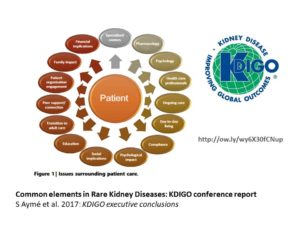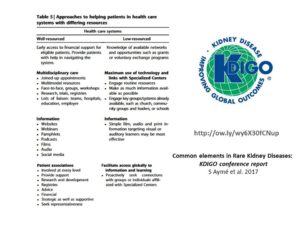
Among rare kidney diseases, there are common clinical and patient issues. Meeting at the KDIGO Controversies Conference Common Elements in Rare Kidney Diseases, a multidisciplinary panel of clinicians joined with patient advocates to create the aHUS & C3G Physician Reference Guide (KDIGO, released 3 Oct 2017). The aHUS Alliance offers this overview of why we consider this new KDIGO report is a ‘must read’ for physicians as well as those diagnosed, or caring for people, with atypical HUS. For the scope of work, agenda, and other details from this KDIGO (Kidney Disease: Improving Global Outcomes) conference held in Amsterdam in June 2016, click here.
When looking at approximately 150 rare kidney diseases, most of which are inherited, one finds common challenges to diagnosis and treatment: small patient populations, lack of knowledge regarding causal factors or disease triggers, few ways to monitor patient status with disease-specific labs or biomarkers, and the need for complex care. This KDIGO physician reference guide is sectioned into components, mentioned here to highlight key areas within the document which will be of high interest to aHUS patient organizations around the world. For additional medical information, the KDIGO Controversies Conference on Complement Mediated Kidney Disease yielded a primary resource for physicians regarding atypical HUS (aHUS) and C3 glomerulopathy (C3G) which can be accessed here. The aHUS Alliance attended the KDIGO meeting in Barcelona which launched these reports, click here to gain the aHUS patient advocacy point of view regarding this KDIGO conference.
The section ‘Diagnostic Challenges’ contains a comprehensive overview of needs, issues, and value of genetic testing. Genetic testing can involve high costs and take many weeks for results to return, but additionally there are wide differences in accessibility and insurance coverage which may be amplified by the geographic location of patients or in settings with limited resources. Genetic testing can help to confirm diagnosis, identify risk factors for recurrence in kidney transplantation, evaluate family members suitability for as kidney donors, and help guide family planning choices. To quote from this section, “In the context of genetic disorders, nephrologists should serve as advocates for patients and their children, always respecting each patient’s religious beliefs, cultural perspectives, and autonomy in decision making. Patients with any genetic diagnosis should be counseled about reproductive options, including germ cell donation, prenatal diagnosis, and preimplantation genetic diagnosis.” Addressed in this section was a concern sometimes mentioned by aHUS families, “All patients should be counseled regarding the ways in which a genetic diagnosis could hinder their ability to obtain health or other types of insurance.”
With any disease affecting the kidneys, measuring and treatment is paramount. The KDIGO report section ‘Managing Decline in Kidney Function’ centers on the assessing and monitoring the glomerular filtration rate (GFR), which is outlined in the 2012 KDIGO CKD Guidelines. This section underscored that healthcare providers must understand and be able to discuss complications with patients and their caregivers, and include them in decisions. To quote further, “A multidisciplinary approach, ideally with assistance from ‘Specialized Centers’ (also designated as Centers of Excellence/ Expertise/ Reference in some jurisdictions, see Table 2) may optimize monitoring and treatment of extrarenal complications.” It was encouraging that this KDIGO document validated concerns of overall patient health by including and addressing the impact of chronic kidney disease and treatment on other body systems and organs (e.g. dialysis comorbidities). A subsection titled ‘Improving standardization and access of optimal care’ spoke to the need for advocacy through patient organizations and noted, “Access to optimal care is critical for the best possible outcomes in patients affected by rare diseases. Governments, other payers, and industry should ensure that all effective treatments are available to patients worldwide. Patient organizations have an important role in advocating for access to affordable, evidence-based care and ideally, universal access to Specialized Centers. In geographic regions or countries without such centers, partnerships between local practitioners and center specialists in other regions or countries should be developed.” The aHUS Alliance takes this role seriously, and has created an international directory of aHUS advocacy and national patient organizations, as well as a global network of aHUS clinicians and investigators to provide this type of support and assistance. The subsection ‘Transitioning from pediatric to adult care’ will be of high interest to aHUS families as well as clinicians, especially the recognition of social/emotional and cognitive aspects which may sometimes be overlooked as children grow to develop an understanding of their health, their care, and the impact of their medical diagnosis on various areas of their lives.
The section ‘Challenges in Clinical Study Design’ outlined a variety of issues and barriers, but arguably one of this document’s most informative and meaningful components was its comprehensive chart of study designs which offered a brief explanation along with the advantages and disadvantages of each type. Small patient populations have long been listed as a primary barrier, however the KDIGO report noted “New strategies have been developed for maximizing information obtained from a limited number of patients by using innovative trial designs.” Working collaboratively across groups and nations can speed advancement in any field, As noted here on the topic of research and clinical trials, “Collaboration and partnership between academia and industry in designing, conducting, analyzing, and publishing results of clinical trials as well as sharing data from clinical trials should be encouraged.” Given KDIGO’s long history of including patients and advocacy organizations at conferences, we found it surprising that patient organizations were not mentioned in this section. Early inclusion of patients and advocacy organizations can provide unique insights, and the aHUS Alliance urges academia and industry to include the patient perspective and experience in their efforts as a valued partners throughout all stages and efforts of design and study.
The section ‘Translation of Research to Clinical Care’ contained more than the standard bench to bedside topics one might traditionally expect. Sharing data is key to fostering advancement, as noted here on the importance of centers of excellence serving a key role in translational medicine, “Connecting these centers with research groups and patient advocacy groups, nationally or internationally, through shared registries or biobanks, research collaboration, meetings, training, and exchanges is vital for distributing expertise and advancing knowledge.” Sharing and storing data were mentioned in this section of the KDIGO report, as were patient registries. Rather than creating data silos or launching separate initiatives, “Improved collaborative efforts by scientific societies and patient organizations to integrate such initiatives, rather than creating competing ones, should be encouraged.” We wholeheartedly agree, and go further to suggest that patient advocates and/or focus groups need to be engaged early and often to ensure effective and efficient communications in such varied areas as patient recruitment and outreach/educational materials. (See the Orphanet article Woodward, L et al 2016, regarding a collaborative partnership and the global aHUS patient registry) Recommendations for establishing rare disease registries were listed, to include open access to data. The general public expects medical protocols to be in place for every condition, yet as noted here “Standards of care are lacking for individual rare kidney diseases. Standards should address all aspects of each disease, be developed with input from patients and relevant providers, and be applicable in low-income countries.” It is frustrating and disheartening for physicians as well as patients to access research that indicates use of therapeutic drugs, treatment options, or disease management plans that are not broadly accessible or financially feasible. A multi-pronged approach to shared information and expanded training were discussed in this section, as was patient empowerment and other topics.
A section on “Providing Practical and Integrated Patient Support” centered on patient needs, issues that face patients and their families, and options for moving toward a more holistic and patient-centric approach to health. This KDIGO report included segments on both the emotional and economic burden of living with a rare kidney disease. “The psychological impact of being diagnosed with an inherited kidney disease is different for every patient and can vary over time with disease progression. Patients and their families can experience anger, fear, grief, anxiety, denial, and depression. For children and adolescents, having CKD increases the risk of developing depression and anxiety.” We would have appreciated recognition of the special challenges faced by patients with an ‘invisible illness’, for those diagnosed with a medical condition not on view to the public but which still impacts daily life. For those people, medical issues can be compounded by friends, co-workers, or others who have difficulty seeing beyond the limiting and mistrustful pronouncement of “You look just fine to me!” This section provided an outstanding comparison of the disparities in health care systems with differing resources (Table 5), serving to underscore just how difficult it is to receive information as well as treatment in a ‘low resourced’ setting. This KDIGO guide presented interesting views regarding information about financial resources which may be available from patient organizations. In the case of the atypical HUS community, the aHUS Alliance is not aware of any aHUS-specific patient organization that provides direct financial assistance to patients. In most nations aHUS patients and caregivers struggle to absorb medical costs and its web of family economic burden. Personal expenses to attend meetings related to support or aHUS advocacy can mount quickly and, even when trip costs are fully covered, most often costs are reimbursed after conclusion of the meeting or event. Many active aHUS advocates around the world are simply volunteers, who feel fortunate whenever basic expenses are covered, although in some nations a few advocates receive a stipend for their time and efforts. In the aHUS community, it will be a challenge to encourage new nations and varied advocacy voices until funding options are reassessed to provide a level playing field that allows for all aHUS advocates to participate at conferences, attend policy meetings, create resources specific to their community, and engage with others to offer views or gain support.
The KDIGO team ends this physician reference guide with Table 6, a forward-looking list of questions or knowledge gaps to address, which will propel advancements through future research. The aHUS Alliance thanks all those involved with the June 2016 meeting in Amsterdam and the creation of this guide to Common Elements in Uncommom Kidney Dieases, and commend the leadership of the KDIGO team, who envisioned a guide that was both meaningful and comprehensive. Well done.


